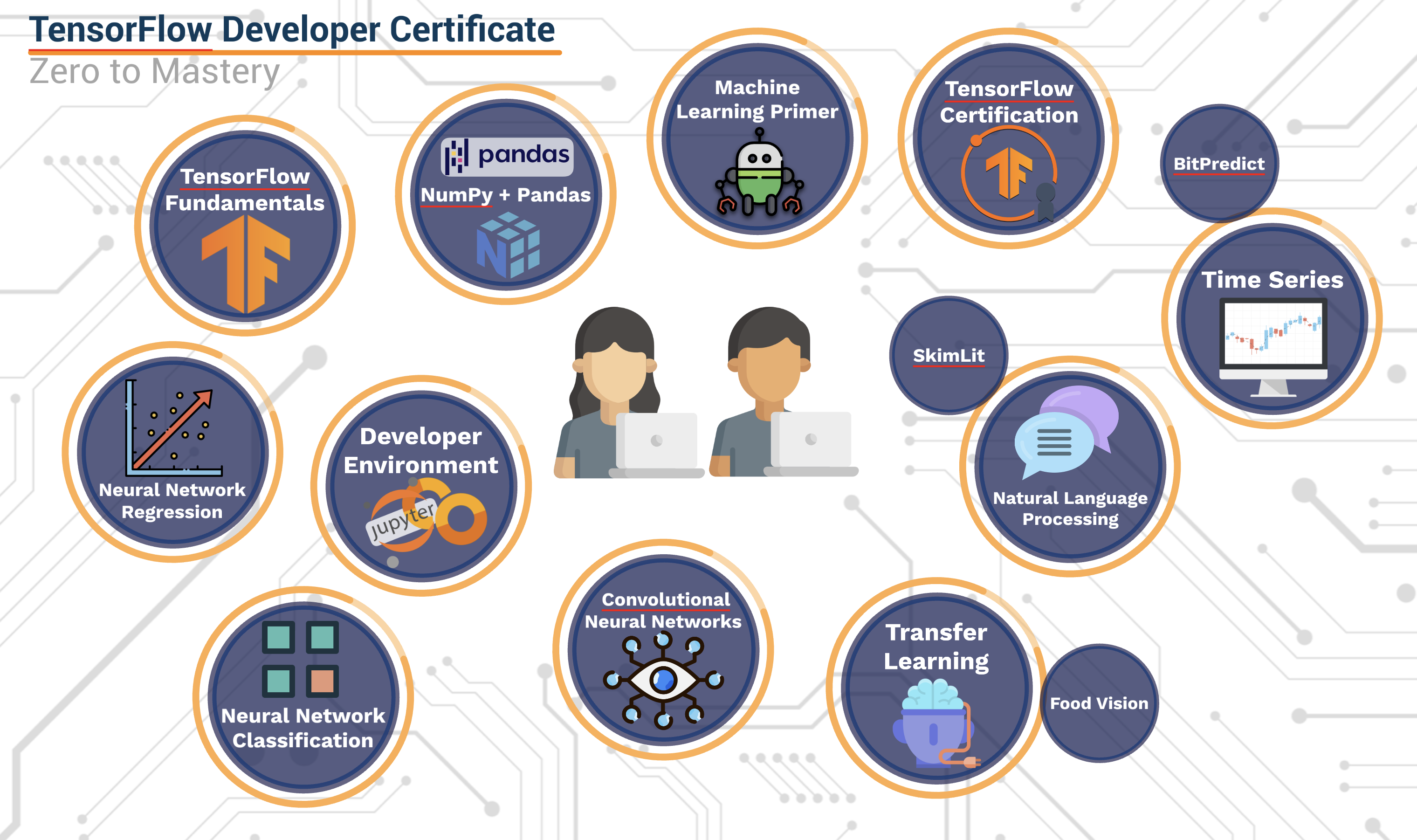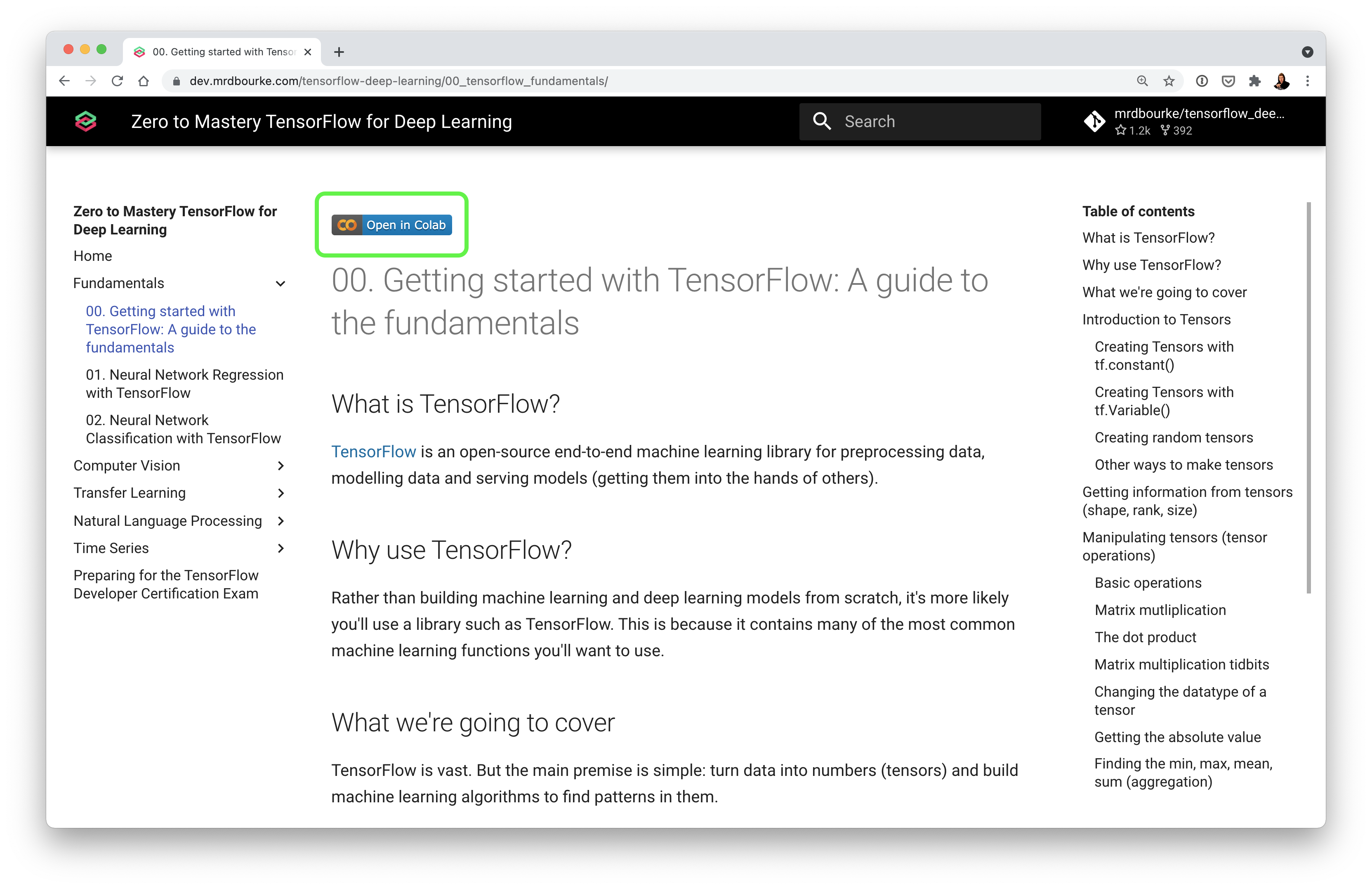Welcome to the Zero to Mastery TensorFlow for Deep Learning Book

This is the online book version of the Zero to Mastery Deep Learning with TensorFlow course.
This course will teach you foundations of deep learning and TensorFlow.
The course is video based. However, the videos are based on the contents of this online book.
For full code and resources see the course GitHub.
Important links
- 🎥 Watch the first 14-hours of the course on YouTube (notebooks 00, 01, 02)
- 💻 Sign up to the full course on the Zero to Mastery Academy (videos for notebooks 03-10)
- 🤔 Got questions about the course? Check out the livestream Q&A for the course launch
- ❓ Stuck? Ask a question on the GitHub Discussions page or see the FAQ
Course materials
The following table represents contents of the book (each notebook is a chapter) with extra links to slides, exercises and extra-curriculum.
Course structure
This course is code first. The goal is to get you writing deep learning code as soon as possible.
It is taught with the following mantra:
Code -> Concept -> Code -> Concept -> Code -> Concept
This means we write code first then step through the concepts behind it.
If you've got 6-months experience writing Python code and a willingness to learn (most important), you'll be able to do the course.
Should you do this course?
Do you have 1+ years experience with deep learning and writing TensorFlow code?
If yes, no you shouldn't, use your skills to build something.
If no, move onto the next question.
Have you done at least one beginner machine learning course and would like to learn about deep learning/TensorFlow?
If yes, this course is for you.
If no, go and do a beginner machine learning course and if you decide you want to learn TensorFlow, this page will still be here.
Prerequisites
What do I need to know to go through this course?
- 6+ months writing Python code. Can you write a Python function which accepts and uses parameters? That’s good enough. If you don’t know what that means, spend another month or two writing Python code and then come back here.
- At least one beginner machine learning course. Are you familiar with the idea of training, validation and test sets? Do you know what supervised learning is? Have you used pandas, NumPy or Matplotlib before? If no to any of these, I’d going through at least one machine learning course which teaches these first and then coming back.
- Comfortable using Google Colab/Jupyter Notebooks. This course uses Google Colab throughout. If you have never used Google Colab before, it works very similar to Jupyter Notebooks with a few extra features. If you’re not familiar with Google Colab notebooks, I’d suggest going through the Introduction to Google Colab notebook.
- Plug: The Zero to Mastery beginner-friendly machine learning course (I also teach this) teaches all of the above (and this course, the one you're reading about now, is designed as a follow on).
How to use this book
All of the materials are taught code-first. The chapters are Jupyter Notebooks (also Google Colab notebooks) which can be run interactively.
You can read all of the materials but they'll be best learned if you practice writing the code yourself.
 To start running a notebook interactively, click the "Open in Colab" button at the top of each chapter.
To start running a notebook interactively, click the "Open in Colab" button at the top of each chapter.
Who made this book?
I did, ah, me, Daniel, Daniel Bourke. I'm a machine learning engineer who makes YouTube videos and writes stories, pop philosophy and machine learning coding tutorials (like the ones contained in this book).
Sometimes documentation and other resources can be a bit hard to read for certain things. So I've done my best to make this a book (and a video course, I mean, that's where this book came from) I'd like to have read when I was getting into the exciting world of deep learning.
Extensions
Enjoyed this book/course?
I'd also recommend the following:
- Neural Networks and Deep Learning Book by Michael Nielsen - If the Zero to Mastery TensorFlow for Deep Learning book is top down, this book is bottom up. A fantastic resource to sandwich your knowledge.
- Deeplearning.AI specializations - This course focuses on code-first, the deeplearning.ai specializations will teach you what's going on behind the code.
- Hands-on Machine Learning with Scikit-Learn, Keras and TensorFlow Book (especially the 2nd half) - Many of the materials in this course were inspired by and guided by the pages of this beautiful text book.
- Full Stack Deep Learning - Learn how to turn your models into machine learning-powered applications.
- Made with ML MLOps materials - Similar to Full Stack Deep Learning but comprised into many small lessons around all the pieces of the puzzle (data collection, labelling, deployment and more) required to build a full-stack machine learning-powered application.
- fast.ai Curriculum - One of the best (and free) AI/deep learning courses online. Enough said.
- "How does a beginner data scientist like me gain experience?" by Daniel Bourke - Read this on how to get experience for a job after studying online/at unveristy (start the job before you have it).
Get ready to dream in tensors!
Onward.